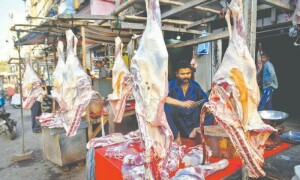• Despite not adhering to district boundaries, 83 NA seats under/overshoot provincial quotas in preliminary delimitation
• Fafen says one-fifth of constituencies do not conform to stipulations of Elections Act 2017
ISLAMABAD: The Election Commission of Pakistan (ECP) seems to have compromised the principle of ‘equality of vote’ in as many as 83 National Assembly constituencies, where the variance in population from the provincial quota exceeds the permissible legal limit of 10 per cent.
A thorough analysis of the preliminary delimitation proposals shows that the largest NA constituency in KP — NA-39 Bannu — has a population of 1,357,890, which is nearly three times more than the smallest constituency, NA-1 Chitral Upper-cum-Chitral Lower, with a population of 515,935.
Under Section 20 of the Elections Act 2017, as far as possible, variation in population of constituencies of an assembly should not ordinarily exceed 10 per cent.
According to the Free and Fair Election Network, ECP was expected to disregard district boundaries to ensure that the variation among the population of an assembly’s constituencies does not exceed 10pc.
This variation among the population of constituencies may be identified by comparing the population of a constituency with the average population per seat of an assembly, also called quota per seat.
The quota is calculated by dividing the population of a province, as determined by the last census officially published, by the number of seats of that province in national or provincial assemblies, as provided in the Constitution. The proposed NA constituencies with more than 10pc population variation included 35 constituencies in Punjab, 22 in Sindh, 21 in KP and five in Balochistan.
The quota for each NA constituency for Khyber Pakhtunkhwa was calculated at 907,913, Islamabad Capital Territory at 787,954, Punjab at 905,595, Sindh at 913,052 and Balochistan at 930,900.
The act allows ECP to deviate from this permissible limit in only exceptional cases and the reasons for any such deviation must be recorded in the delimitation order.
This means that the population if each constituency can be, at most, 10pc above or below the provincial quota.
However, a cursory look at the population number of constituencies such as NA-13 Battagram (554,133), NA-40 North Waziristan (693,332),NA-16 Abbotabad-1 (699,311), NA-17 Abbottabad-II (719,761), NA-45 D.I. Khan-II (763,267), NA-43 Tank-cum-D.I. Khan (764,095), NA-44 D.I. Khan-I (772,742), NA-37 Kurram (785,434) and NA-7 Lower Dir (796,571) show that they are far below the 10pc threshold envisioned in the law.
On the higher side, NA-8 Bajaur and NA-35 Kohat have a population size of 1,287,960 and 1,234,661, respectively. Likewise, the population of NA-18 Haripur is 1,174,783, followed by NA-27 Khyber (1,146,267). These are also above the 10pc threshold.
Other constituencies with population of over one million include NA-12 Kohistan, NA-41 Lakki Marwat, NA-15 Mansehra-cum-Tor Ghar and NA-10 Buner.
Punjab
The largest proposed NA constituency in Punjab is NA-49 Attock-I, with a population of 1,126,142, versus the smallest NA-61 Jhelum-II, having a population of 690,683.
Other constituencies with smaller population sizes include NA-60 Jhelum-I (691,625) and NA-180 Kot Addu (713,922).
Other constituencies in the province having population of more than one million include NA-181 Layyah-I, NA-182 Layyah-II, NA-139 Pakpattan-I, NA-140 Pakpattan-II, NA-141 Sahiwal-I, NA-50 Attock-II, NA-79 Gujranwala-III, NA-80 Gujranwala IV, NA-81 Gujranwala cum Hafizabad and NA-92 Bhakkar.
All three constituencies of Jhang, three out of four constituencies in Kasur and two out of four constituencies in Sheikhupura also have a population of over a million.
Sindh and Balochistan
In Sindh, NA-209 Sanghar-I is proposed to have a population of 1,172,516, while NA-221 Tando Muhammad Khan is carved out with a population of 726,119. NA-213 Umer Kot has a population of 1,159,831, followed by NA-210 Sanghar-II (1,117,308).
Other constituencies with population size exceeding a million in the province include NA-223 Badin-I, NA-225 Thatta, NA-232 to 234 Karachi Korangi, NA-235 Karachi East-I and NA-242 and 243 Karachi Kemari.
In Balochistan, NA-255 Sohbatpur-cum-Jaffarabad-cum-Usta Muhammad-cum-Nasirabad has a population of 1,124,567 and in contrast NA-261 Quetta-I has a population of 799,886.
Provincial constituencies
Meanwhile, according to Free and Fair Elections Network (Fafen), as many as 180 constituencies of the national and provincial assemblies as proposed by the ECP do not meet the legal preferability of 10pc variation in population, undermining the principle of equal suffrage that was otherwise upheld by parliament through latest amendments to the Elections Act 2017.
Fafen points out that the provincial assembly (PA) seat quota for Khyber Pakhtunkhwa was established at 355,270, Punjab 429,929, Sindh 428,432 and Balochistan 292,047.
This means that more than one-fifth of the total constituencies demarcated do not comply with Section 20 (3) of the Elections Act.
The PA constituencies with such anomalies include 30 in KP, 26 in Punjab, 25 in Balochistan and 16 in Sindh.
KP’s largest constituency PK-93 Hangu (528,902) hosts almost three times the population of the smallest i.e., PK-1 Upper Chitral (195,528). Similarly, the largest PA constituency in Sindh, PS-75 Thatta-I, has a population of 556,767, while PS-79 Jamshoro-II is the smallest with a population of 354,505.
Punjab’s largest PA constituency, PP-177 Kasur-III has a population of 510,875, while the smallest PP-84 Khushab-IV has a population of 359,367. In Balochistan, PB-51 Chaman with a population of 466,218 is the largest constituency, which is two and a half times bigger than the smallest constituency i.e. PB-23 Awaran with a population of 178,958.
Ease of filing representations
Fafen has also called upon the ECP to enhance the voter-friendliness of the process of filing representations on the draft constituencies.
Currently, every voter seeking to file a representation on delimitation has to travel to Islamabad for its submission and subsequently for hearings at the ECP Secretariat, which bears additional costs and efforts.
The ECP may consider allowing submission of the representation at its district, regional, and provincial offices. Similarly, the hearings on these representations may be arranged at the provincial level.
Fafen has also urged the commission to direct the Pakistan Bureau of Statistics to promptly publish on its website the census block-wise data of population as under Rule 12(2), voters would require this data for filing representations.
Published in Dawn, October 1st, 2023














































Dear visitor, the comments section is undergoing an overhaul and will return soon.